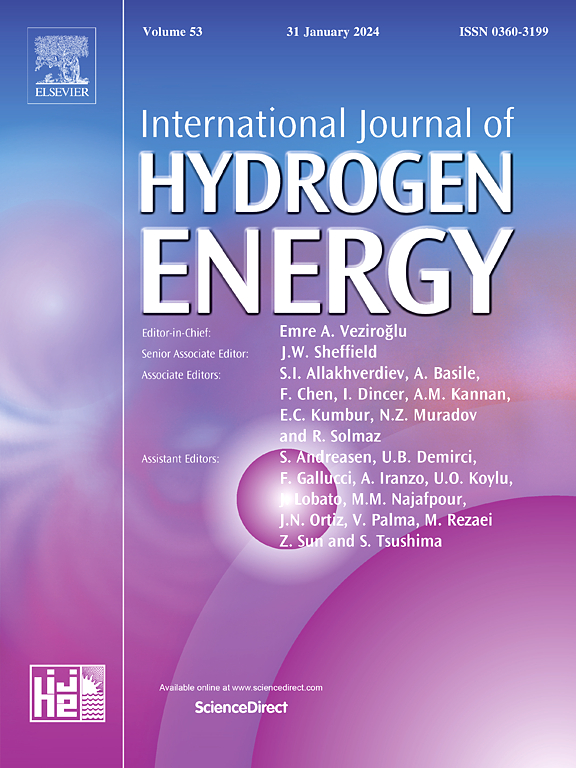Control of spatial nickel distribution inside pellet catalysts for reforming of biogas with additional steam
IF 8.1
2区 工程技术
Q1 CHEMISTRY, PHYSICAL
引用次数: 0
Abstract
Growing concerns over climate change and the increasing demand for renewable energy have intensified interest in utilizing biogas. Among various strategies, the combined reforming of methane (CRM), which utilizes CH4 and CO2 from biogas and H2O, has attracted attention. Nickel-based catalysts are extensively studied for CRM due to their high activity; however, they suffer from rapid deactivation caused by coking. In this work, Ni/Al2O3 egg-shell type pellet catalyst was investigated to address these challenges. To simplify synthesis, a novel developed wetness impregnation (DWI) method was introduced, allowing the concentration of the active phase near the outer region of the pellet. Characterization results revealed that the egg-shell catalysts exhibited higher surface nickel concentrations than their actual nickel content. Although this localization of the active phase led to lower nickel dispersion compared to homo type catalysts, it suggested improved accessibility of reactants to active sites and enhanced reducibility at lower temperatures. Among catalysts, the 2E-T0.1 catalyst (2 wt% Ni, 0.10 mm egg-shell thickness) showed the highest CH4 and CO2 conversions, improved long-term stability, and superior coking resistance at 700 °C, compared to the homo type catalysts. Additionally, controlling the steam ratio indicated the possibility of producing H2-rich syngas (H2/CO). This indicates the role of spatial nickel distribution in optimizing catalytic performance and coking resistance. In particular, egg-shell catalyst with thin shell offers a promising strategy for efficient biogas reforming applications.

附加蒸汽重整沼气球团催化剂镍空间分布的控制
对气候变化的日益关注和对可再生能源需求的不断增加,增强了人们对利用沼气的兴趣。在各种策略中,利用沼气和H2O中的CH4和CO2的甲烷联合重整(CRM)备受关注。镍基催化剂因其高活性而被广泛研究;然而,它们会因焦化而迅速失活。在这项工作中,研究了Ni/Al2O3蛋壳型颗粒催化剂来解决这些挑战。为了简化合成,介绍了一种新型的湿浸渍(DWI)方法,允许活性相的浓度接近球团的外部区域。表征结果表明,蛋壳催化剂的表面镍浓度高于其实际镍含量。虽然与同型催化剂相比,这种活性相的定位导致镍的分散性较低,但它表明反应物更容易接近活性位点,并在较低温度下增强了还原性。在催化剂中,与同类催化剂相比,2E-T0.1催化剂(2 wt% Ni, 0.10 mm蛋壳厚度)具有最高的CH4和CO2转化率,改善了长期稳定性,并且在700℃下具有优异的抗焦化性能。此外,控制蒸汽比表明有可能产生富H2合成气(H2/CO)。这表明镍的空间分布在优化催化性能和抗结焦性能方面的作用。特别是薄壳的蛋壳催化剂,为高效的沼气转化应用提供了一种很有前景的策略。
本文章由计算机程序翻译,如有差异,请以英文原文为准。
求助全文
约1分钟内获得全文
求助全文
来源期刊

International Journal of Hydrogen Energy
工程技术-环境科学
CiteScore
13.50
自引率
25.00%
发文量
3502
审稿时长
60 days
期刊介绍:
The objective of the International Journal of Hydrogen Energy is to facilitate the exchange of new ideas, technological advancements, and research findings in the field of Hydrogen Energy among scientists and engineers worldwide. This journal showcases original research, both analytical and experimental, covering various aspects of Hydrogen Energy. These include production, storage, transmission, utilization, enabling technologies, environmental impact, economic considerations, and global perspectives on hydrogen and its carriers such as NH3, CH4, alcohols, etc.
The utilization aspect encompasses various methods such as thermochemical (combustion), photochemical, electrochemical (fuel cells), and nuclear conversion of hydrogen, hydrogen isotopes, and hydrogen carriers into thermal, mechanical, and electrical energies. The applications of these energies can be found in transportation (including aerospace), industrial, commercial, and residential sectors.
 求助内容:
求助内容: 应助结果提醒方式:
应助结果提醒方式:


